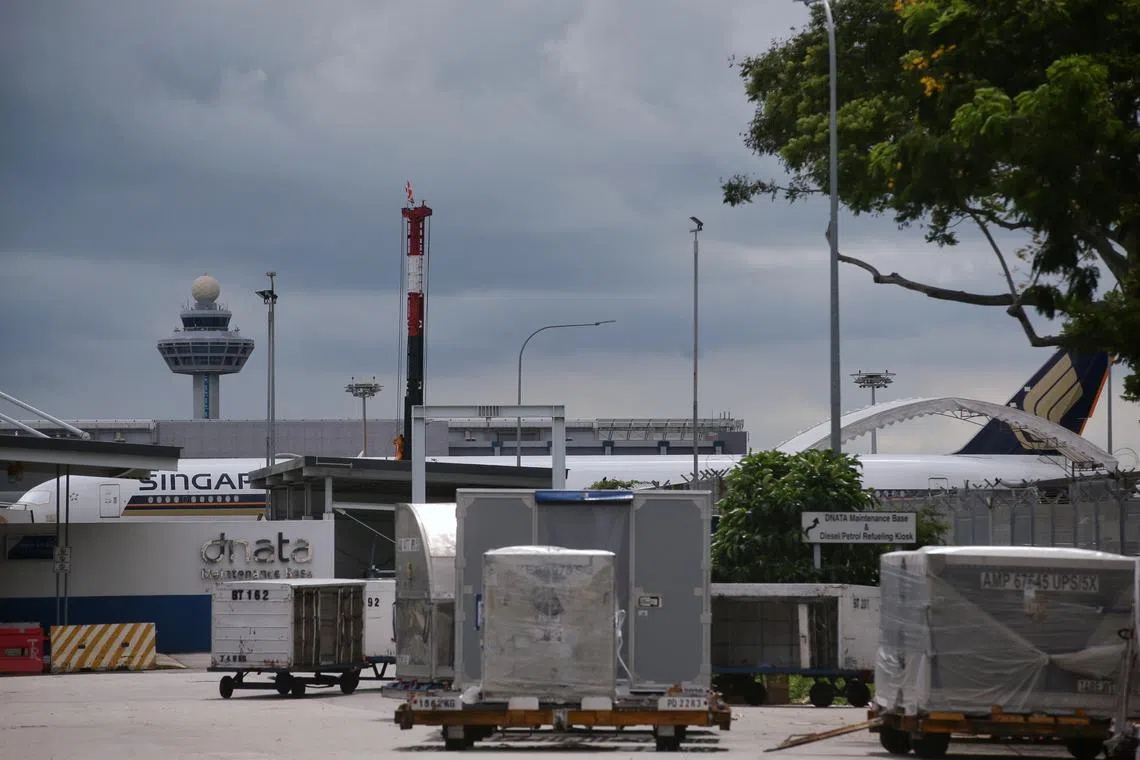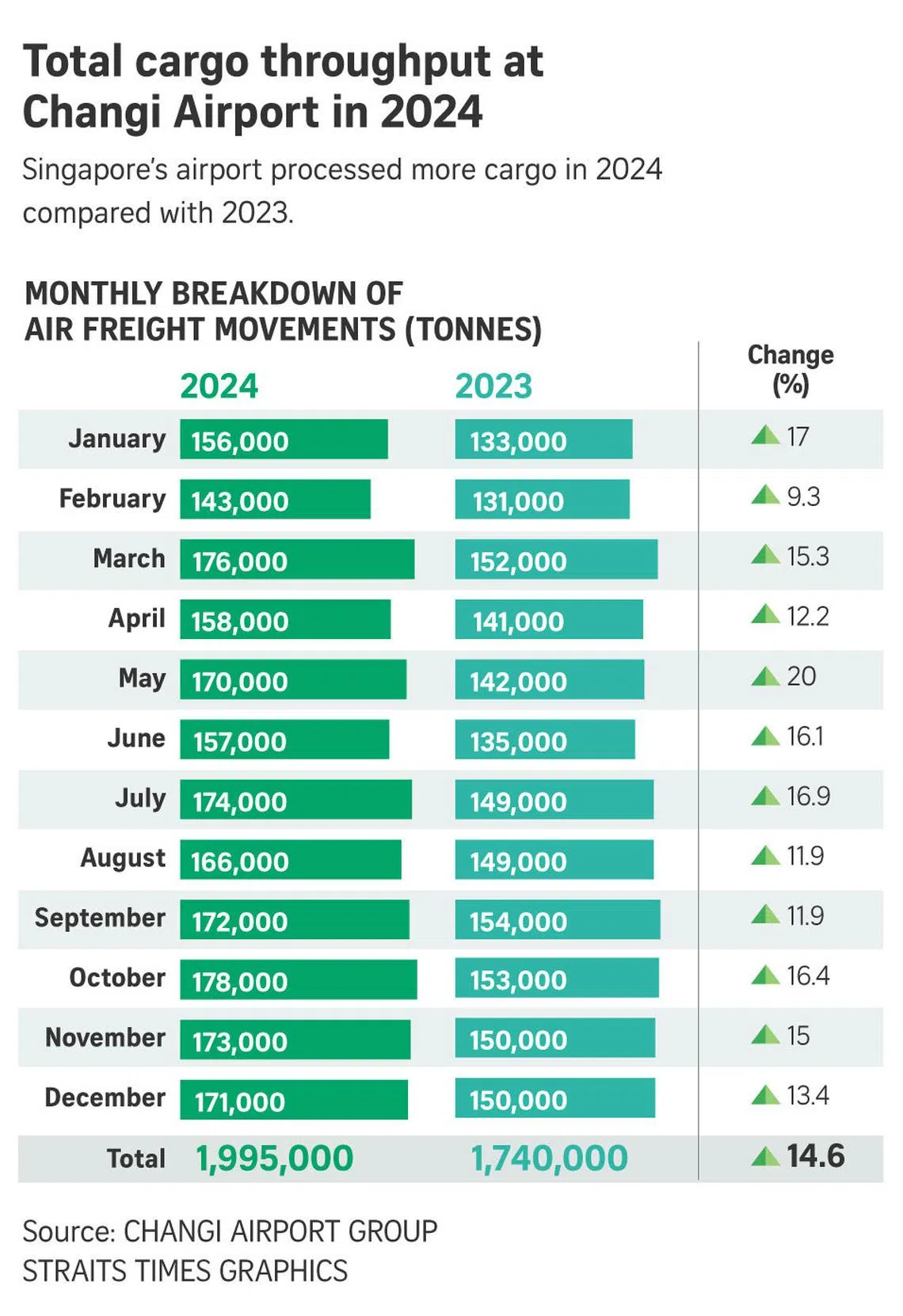Changi Airport to focus on e-commerce, pharmaceutical shipments as cargo capacity tightens
Sign up now: Get ST's newsletters delivered to your inbox

Changi Airport Group handled 1.99 million tonnes of airfreight in 2024, up 14.6 per cent from the 1.74 million tonnes in 2023.
PHOTO: ST FILE
Follow topic:
SINGAPORE – Cargo volumes at Changi Airport surged in 2024 on the back of strong global demand for shipments through Singapore, and a shift from ocean to airfreight due to disruptions in the Red Sea.
Changi Airport Group (CAG) reported on Jan 23 that it handled 1.99 million tonnes of airfreight, up 14.6 per cent from the 1.74 million tonnes in 2023. Its top five markets were China, Australia, the US, Hong Kong and India.
CAG also saw major improvements in cargo flows between Singapore, China and the US, in addition to a recovery in domestic electronics exports and re-exports.
Two new freighter routes were added in 2024 that connected Singapore to Haikou in China and Nagoya in Japan. Two new airlines – Shandong Airlines and Air Incheon – also started operating freighter services from Changi.
Mr Lim Ching Kiat, executive vice-president of air hub and cargo development at CAG, told The Straits Times that the airport expects further growth in intra-Asia trade, noting: “Asean has become the largest export trading partner for China.
“As some trade routes shift from China to South-east Asia and with rising exports from the region to China, it has become critical for us to remain competitive by deepening our connectivity with major gateways in China as well as the region.”
He added that cargo capacity at the airport’s existing facilities will be tight on the back of greater regional growth until fresh capacity comes on stream from 2030.
In the meantime, CAG must prioritise the tenant mix and type of cargo it plans to handle while optimising space at its existing facilities, noting that it wants to focus on pharmaceuticals and e-commerce shipments.
Mr Lim said CAG has already developed an ecosystem to handle pharmaceutical products within the airport.
With global biopharma heavyweights such as Thermo Fisher, Sanofi, BioNTech and MSD continuing to invest here, Singapore has also become the preferred gateway for the regional distribution of pharmaceuticals.
CAG is now talking to its partners to build up a similar hub and supply chain for e-commerce.
“E-commerce has emerged as a key growth driver of the global air cargo industry. New entrants have also come onto the scene, such as fast-fashion giants Shein and Temu, and social commerce heavyweight TikTok Shop,” Mr Lim said.
He noted that South-east Asia’s e-commerce market is expected to grow at an average rate of 22 per cent annually from now to 2026.
“To that end, Changi is collaborating with key air cargo partners to ensure the provision of purpose-fit warehousing and handling facilities, seamless Customs procedures and efficient airport operations to serve the needs of global and regional e-commerce logistics players here,” Mr Lim said.

CAG recently also refurbished an existing warehouse for a new 8,000 sq m air logistics facility, Changi Nexus One, which will have more space and better access to cargo handling equipment.
“We are currently in advanced discussions with potential tenants of Changi Nexus One. With the new facility, the new logistics partners will be able to better enhance their special cargo handling capabilities for pharmaceuticals and e-commerce, and better serve the in-transit needs of global customers,” said Mr Lim.
These initiatives are expected to help CAG maximise space until fresh cargo handling capacity comes on stream from the mid-2030s onwards. This will comprise a new airfreight centre, a free-trade zone and logistics park to accommodate regional distribution and freight-forward operations, among others.
The moves also come amid expectations that air cargo demand will continue to outpace capacity in 2025.
Analysts at freight data platform Xeneta projected on Jan 9 that global air cargo demand would grow by 4 per cent to 6 per cent year on year in 2025, outpacing global cargo capacity supply growth of 3 per cent to 4 per cent.
They added that any further disruptions to global ocean freight will likely see shippers opting to ship urgent cargo by air, noting that a three-day strike at US ports in October 2024

